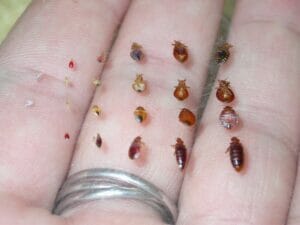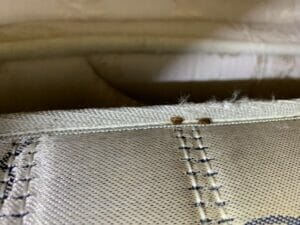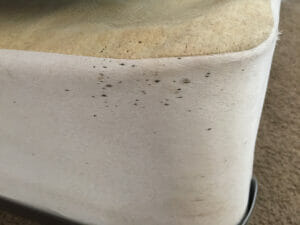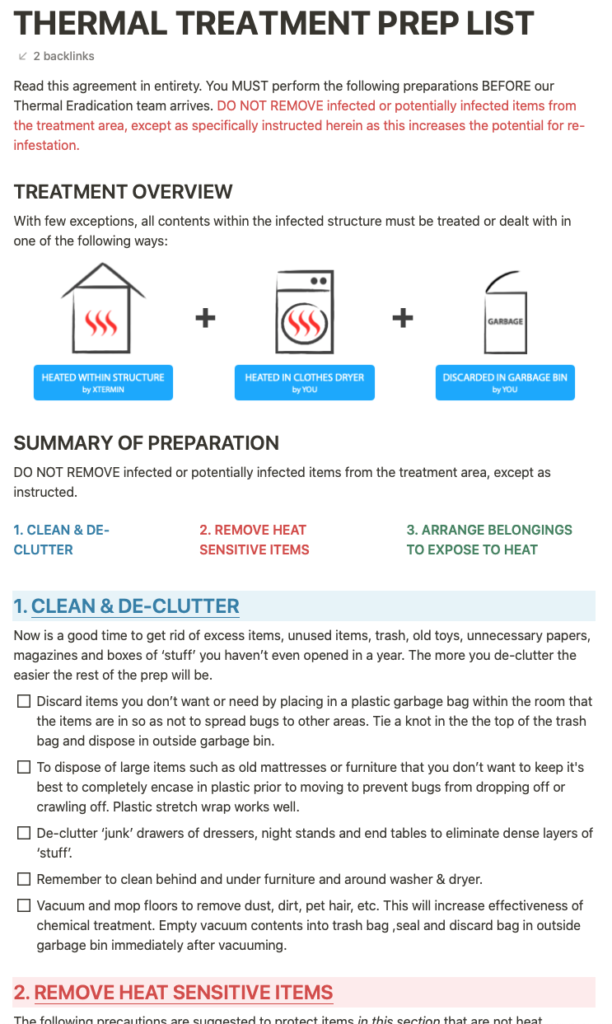Bed Bugs & Cimicidae Frequently Asked Questions
What are bed bugs, also called Cimicidae?
 Adult bed bugs are reddish-brown colored insects that are about the size of an apple or watermelon seed and are relatively flat unless they recently fed. Adult bed bugs also have textured lines running horizontally across the back of the bug. Bed bug nymphs (baby bed bugs) are a cream color and somewhat translucent. If the nymphs have fed recently they may appear red or have a dark spot in their abdomen. In this section, learn answers to some of the most common FAQ related to the appearance and characteristics of bed bugs.
Adult bed bugs are reddish-brown colored insects that are about the size of an apple or watermelon seed and are relatively flat unless they recently fed. Adult bed bugs also have textured lines running horizontally across the back of the bug. Bed bug nymphs (baby bed bugs) are a cream color and somewhat translucent. If the nymphs have fed recently they may appear red or have a dark spot in their abdomen. In this section, learn answers to some of the most common FAQ related to the appearance and characteristics of bed bugs.
Do bed bugs have wings?
Bed bugs do not have wings and they cannot fly.
Can you see bed bugs?
 Yes, adult bed bugs can be seen with the naked eye. They are the size of an apple or watermelon seed. Early-stage bed bug nymphs are barely visible to the naked eye and are often only found if they are moving as your eye notices the movement. They often only move to feed or when physically disturbed and usually go unnoticed.
Yes, adult bed bugs can be seen with the naked eye. They are the size of an apple or watermelon seed. Early-stage bed bug nymphs are barely visible to the naked eye and are often only found if they are moving as your eye notices the movement. They often only move to feed or when physically disturbed and usually go unnoticed.
Do bed bugs jump?
Bed bugs do not jump, but they can crawl quickly.
Do bed bugs bite?
Bed bugs typically bite people while they are sleeping, because they are most active at night. They pierce the skin and suck blood through a straw-like mouthpart, similar to a mosquito. Bed bugs will usually attach to their human host 3-5 times in a single feeding. A common sign of evidence of bed bugs is if you find 3 to 5 bites in a grouping or line or multiples of these groups of bites. If conditions or ideal, a bed bug will typically feed once every 4-7 days. However, if they are not comfortable with the condition or environment, they may stop feeding temporarily.
How long can bed bugs live without food?
Bed bugs can go without feeding on human or animal blood for up to about 12 months. The amount of time they can live depends on their stage of maturity, as well as on temperature and humidity in the home or environment.
Can dogs get bed bugs?
Yes. Bed bugs feed on both humans and animals, so your dogs, cats and other furry creatures living in your home are also at risk when there is an infestation. However, it is uncommon for bed bugs to feed on animals when humans are available.
Do bed bugs live on you?
Bed bugs do not live on their host. Bed bugs will get on their host (usually a human), feed for 5-20 minutes and crawl back to their nearby hiding spot.
What are the signs of bed bugs and where do they come from?
There are a variety of signs of bed bugs. Typically, the earliest sign of bed bugs is waking up in the morning with several itchy bites in a grouping or line on your skin that were not there before you went to bed. Common sources of bed bugs are used furniture, house guests, hotels, sleep-overs, vacation rentals, friends & family with bed bugs, etc. In this section, learn answers to some of the most common FAQ related to the signs of bed bugs as well as how they spread and get into your home.
How do you know if you have bed bugs?
You should suspect bed bugs if:
- You wake up in the morning with clusters or lines of bites on your skin and you know you weren’t exposed to mosquitos. Although mosquitos ‘bite’ randomly, they are often confused with bed bugs because mosquitos usually feed on exposed skin which often results in a grouping of bites – like around your calves and ankles when wearing shorts.
- You notice bed bug fecal stains on your bedding. Fecal stains are a liquid stain dark gray in color that look similar to taking a fine felt-tip marker and touching your sheet. That small amount of ink that would absorb into the fabric would be similar to a bed bug fecal stain. All fecal excretions are liquid and NOT a solid.
- Bed bug eggs. These are yellowish cream colored and look like a small grain of rice (these are often hard to spot, however)
How do bed bugs get in your home?
Bed bugs are very efficient hitchhikers. Bed bugs often get into your home when people buy used furniture or mattresses. They also hitchhike in luggage, backpacks, shoes, clothing, etc. You can get bed bugs by visiting someone with bed bugs and having a bug or two crawl on to you. You can get them by sitting in a bed bug infested seat at a movie theater, airport, doctors office, restaurant, pew at church, etc. Depending on the construction of the building, they can sometimes travel between apartments in multifamily buildings or between hotel rooms. Bed bugs do not live outside in your yard. Your dog did not bring bed bugs in from the grass.
How do bed bugs spread?
Bed bugs usually spread by hitchhiking on people or things from an infested site. Infested sites are usually places where humans sit, sleep or lounge.
How to get rid of bed bugs?
There are a variety of ways to get rid of bed bugs, but some are more effective than others. In this section, learn answers to some of the most common FAQ related to getting rid of bed bugs.
Realistically, how long does it take to get rid of bed bugs?
If you hire a reputable bed bug expert like Xtermin, who has the knowledge, experience and professional heating equipment, you can be bed bug free in about 8 hours.
If you opt for chemical treatment(s), you will have live bed bug activity for up to about 2 months. With any chemical treatment from any company, it takes about 4-8 weeks for bed bugs to crawl out of hiding and bed bugs eggs to hatch out and crawl through the chemical, the chemical to work its way into the bug, and the bed bug to die off from exposure. During these couple months, you must follow proper protocols to avoid spreading them to others.
Fumigation is another form of chemical treatment. This is where a tent is placed over the entire structure and toxic gas is released inside. This method is rarely used for bed bug treatments since it is more dangerous, obvious (huge tent over your house), expensive and time consuming compared to a heat treatment. About the only reason anyone might consider fumigation is if the structure is also infested with dry-wood termites – although heat treatments can eradicate termites also.
How to get rid of bed bugs fast and permanently?
The fastest way and the only permanent way to kill bed bugs with the highest success rate is with structural heat treatment. It’s important that your exterminator uses the most powerful professional bed bug heaters and safely follows scientifically proven time/temperature targets using state of the art temperature monitoring systems. This will ensure that your home or business will be bed bug free in about 8 hours. By the end of the 8 hour treatment, all bed bugs, bed bug nymphs and bed bug eggs will be dead. And that means you can sleep well that very same night.
How to get rid of bed bugs yourself at home?
DIY bed bug removal is possible with a lot of patience, persistence, work, research and luck. Your options are to rent heaters or to apply chemicals. There are many variables that affect which type of treatment is best for you, which products to use and how likely you are to be successful. There are also a variety of home remedies people say will get rid of bed bugs, including vacuuming, steam cleaning, silica gel, baking soda and rubbing alcohol. While some of these treatments may help over a long period of time, they are not a reliable way to permanently rid your home of bed bugs. The quickest and most effective bed bug removal option is a professional bed bug heat treatment. A professional chemical treatment may be an effective option if you have the patience for it and the infestation is minimal and caught early.
How to get rid of bed bugs naturally?
How to get rid of bed bugs yourself?
Many people who are worried about the cost of bed bug treatment try to get rid of bed bugs themselves using some home remedies and natural treatments found doing online research. Here’s a short list of the most common products inexperienced pest control companies and homeowners use that DO NOT WORK and often create a bigger problem by causing bed bugs to spread more throughout the structure and build up resistance to chemicals:
- Diatomaceous Earth (DE)
- Bed Bug Bombs (foggers)
- ‘Hot Shot’ branded chemicals
- All ‘bed bug’ chemicals sold at big box retailers
- Most traditional professional pest control chemicals (ie. Pyrethroid insecticides)
- Lavender Oil (or any of your favorite fragranced oils)
Here’s what happens with nearly all DIY treatments: You will see dead bed bugs and think that whatever you did is working. What really happens is that whatever you applied is killing the bugs you directly sprayed and the weaker bugs. The strong bugs will survive and their offspring will become more resistant to chemicals with each new generation. The surviving bugs will often go into hiding until the chemical smells dissipate and they feel safe to come out to feed – sometimes 2-3 months later. You’ll apply another round of chemicals with even less success. Depending on your tolerance (and stubbornness according to the wives of many of our customers), you may fight this fight for a year or so until you finally give up and call an expert. In the meantime, you are likely spreading bed bugs to places you go and to people that come into your home or business.
Does renting a bed bug heater work?
There are companies around the country that will rent bed bug heaters, fans and related equipment. The heaters they rent usually run off electricity (plug into multiple electrical outlets) and put out a relatively small amount of heat compared to the high-end heaters we use that run off of propane. (Due to liability concerns, we are unaware of any company that will rent high output professional heaters similar to what XTERMIN uses for structural heating). These low-powered rented heaters are really only effective at treating a single bedroom or similarly small area. We have treated many homes AFTER the homeowner has rented heaters multiple times and failed because it takes more than just sticking a heater in a room and letting it run.
Advantages:
- Sometimes less expensive than hiring a professional to heat treat your home.
Disadvantages:
- Rented heaters usually run off of electricity and are underpowered for most bed bug infestations.
- Rented bed bug heaters usually only output about 10,000-20,000 BTU (heat output measurement). Comparatively, XTERMIN heaters output over 900,000 BTU. Yes, our heaters are ~45 to 90 times more powerful.
- Bed bugs are usually not just in one bedroom and there is no professional inspection that can locate every bed bug in your home and guarantee the results of an inspection. First stage bed bug nymphs are barely visible to the naked eye and if one or two hitchhiked their way from one room to another or to the couch – there is no inspection that will find those bugs with 100% accuracy. This is one example of where luck is a big factor. If you luck out and only happen to have bed bugs in one bedroom and you properly prep the room for treatment and correctly heat treat it reaching the necessary temperatures everywhere for the right amount of time – then you will be successful.
- By heating only a portion of the structure there is an increased risk of bed bugs migrating out of the heated area to a non-heated area, further infesting the structure. Bed bugs are very heat sensitive and as the temperatures rise they will migrate to colder areas if they can find them. To perform a heat treatment correctly you should have a basic understanding of thermodynamics and bed bug behavior.
- Heaters can be dangerous if not used correctly and monitored during treatment.
- It is common for DIYers to under-heat (not high enough temps for the correct amount of time) or overheat (get too hot and cause damage).
- It is common for DIYers to not properly prep the area resulting in a failed treatment.
Does Diatomaceous Earth kill bed bugs?
Diatomaceous Earth (DE) is one of the many chemicals that is not effective at killing bed bugs. Although it may kill some bed bugs, only luck will result in 100% eradication. Our experience with hundreds of customers who have tried self-treating with DE (and often a lot of DE), only to eventually give up and hire XTERMIN, shows the ineffectiveness of DE as a treatment method. Using this product often creates a bigger problem by allowing bed bugs to spread more throughout your home while you slowly learn that it’s not working.
Professional bed bug treatment options and treatment prep recommendations
How does bed bug heat treatment work?
Our professional 2-stage thermal heat + pesticide treatment is the most effective & recommended method to kill bed bugs. Our thermal treatment will kill 100% of the bed bugs and the eggs in 8 hours – backed by the best warranty in the industry!
- Bed Bug Free in 8 Hours
- 2-Year Warranty
- Keep Your Mattress & Furniture
- Child & pet safe residual treatment included free
- Kills other unpleasant pests (insects, bacteria, fungi, protozoa, viruses) many of which are human pathogens.
- Eliminates or reduces unpleasant odors
How to prep for bed bug heat treatment?
 Proper preparation is vitally important to a successful treatment. Most people require 2-3 days to prep. Some can prep in 4-5 hours and some need 4-5 weeks. How long it will take you depends mostly on how clean and clutter-free your house is currently, how much ‘stuff’ you have and how much energy you can put into the work. XTERMIN will provide you with complete and detailed prep instructions. Here is a sample.
Proper preparation is vitally important to a successful treatment. Most people require 2-3 days to prep. Some can prep in 4-5 hours and some need 4-5 weeks. How long it will take you depends mostly on how clean and clutter-free your house is currently, how much ‘stuff’ you have and how much energy you can put into the work. XTERMIN will provide you with complete and detailed prep instructions. Here is a sample.
How does bed bug chemical treatment work?
Chemical treatment can also be effective when applied correctly with the right proven products. However, even the best pesticides will not reliably kill bed bug eggs and it requires more patience as all chemical treatments take time to infect and kill off the infected bugs and newly hatched bed bug nymphs. Most of our chemical treatments are effective with one treatment, although you may still have some bed bug activity for 30-60 days.
- Lower cost
- Large open-air structures where heat can’t be contained (i.e. Airport)
- 30-60 days until bed bug free
- Furniture may have to be discarded
- Laundering / Dry-cleaning expense
- Shorter warranty
Is bed bug steam treatment effective?
Although the steam cleaner method is used by some pest control companies for bed bugs, stay away from anyone that does it. This is the least effective way of doing a ‘heat’ treatment. It is impossible to get the wand and steamer head inside of a box spring mattress, nightstand, or wall which makes it impossible to get the heat where it needs to be. Bed bugs are also heat sensitive and will simply crawl away from the slow-moving steamer head. And if they move the steamer head faster then the heat will not penetrate the cracks and crevices effectively.
One room treatment - is that an option?
We have successfully performed many one-room or single room treatments however there are real risks when only treating one room. The reality is that there is no expert – human or K9 that can ethically guarantee there aren’t bed bugs in any particular room. If a bed bug nymph made its way from a bedroom to the couch last night, it is highly unlikely it will be found during an inspection. Keep in mind they only feed once every 4-7 days and can go up to a year without feeding so just because you haven’t been bit doesn’t mean anything. Also remember that 1/3 of the population doesn’t react to bed bug bites so ‘not getting bit’ doesn’t mean you don’t have them.
The type of scenario that might make sense for a one-room treatment is if you caught the problem very early and the occupant of the room doesn’t go in other parts of the house. They don’t share a bathroom, don’t use the kitchen or living room and you haven’t done any kind of DIY chemical treatment that often causes bed bugs to spread.
You are basically hedging your bets. If there is a fertile bed bug outside of that room, the money spent on the one-room treatment will have been wasted as that bed bug will continue to reproduce in other parts of the house.
How much does it cost to get rid of bed bugs?
What is the cost of bed bug heat treatment?
The cost of a professional structural bed bug heat treatment by a reputable company usually varies between $.80 – $3 per square foot – depending on location, logistics, and other circumstances specific to each job. As an example, at XTERMIN, the average single family home of 1800 sq ft will cost $1800 (± $300). For situations where it makes sense to heat treat a single room or small area, cost could be as low as about $500.
Give us a call for a free consultation and custom quote. Unlike most of our competitors, we can usually answer all of your questions and provide you with a fixed quote right over the phone and get you scheduled right away. Most other companies will require an ‘inspection’, which is really just a way for them to get a salesperson in your house. If you are uncertain if you have bed bugs then an inspection is likely necessary.
What is the cost of bed bug chemical treatment?
Some people choose chemical treatment for bed bugs because it is sometimes more affordable at about 50% – 70% of the price of a proper heat treatment. There are often other costs related to chemical treatments that people don’t always consider or know about:
Other possible chemical treatment related costs:
- Bed bug mattress encasements. Quality encasements cost $40-$80 each and you need one for each box spring and mattress. This can quickly add up to ~$700 for 4 beds.
- Discarding & replacing infested furniture. Different companies will have different recommendations depending on your specific circumstances.
- Unpaid time-off from work. Responsible employers will often not allow employees back to work until after proof of effective treatment. Many employers who are informed to the realities and limitations of chemical treatments to achieve complete eradication of bed bugs will not allow employees to return to work until sufficient time has passed and no evidence is detected during post-treatment inspections.
- If needed (see point above about employers), the most reliable post-treatment chemical inspection is a K9 inspection 45-60 days after treatment. Cost for a K9 inspection is ~$250-$450.
- Additional laundry expenses. All clothing and linen should be run through the dryer on high heat for ~40 minutes. The quickest and simplest way is to use a laundromat with multiple dryers.
- Too often, while one family member is either self-treating or going through the process of a professional chemical treatment (before all bed bugs are dead), they will accidentally infest other family members houses resulting in the expense of treatment for those newly infested homes.
Because it is cheap and easy for a pest control person to buy and spray chemicals, there are a lot of technicians with very little experience with bed bugs performing chemical treatments using bad methods and ineffective chemicals. This results in many failed treatments and frustrated customers. Be cautious, research who you hire and hire those with good reputations specific to bed bug treatments.
What if I’m a renter? Am I responsible for the cost of bed bug treatment?
Your lease agreement is your contract with the landlord. Read your lease agreement to see if it states who is responsible for bed bug problems and sets policy surrounding bed bugs. If it doesn’t specify bed bugs, then it would fall under general pest control policies written in the lease.
We have found that most large apartment complexes where there is a management office on site, will require you to use their contracted pest control company. Unfortunately, these pest control contractors will usually only offer chemical treatment and are not experts in bed bugs. Some tenants are successful insisting on permission to hire their own outside company.
If you rent your house, most landlords allow and expect the tenant to hire their own professional. Read your lease agreement.
It’s also recommended to let your landlord know about the situation so they can mitigate the damage before bed bugs infest any other units in the building. This applies to apartments, condos and other dwellings with shared walls, floors and ceilings since bed bugs can migrate to and infest different parts of a multifamily building.
Additional Bed Bug FAQ
Do I have to throw away my mattress or couch?
When performed correctly, bed bug heat treatment will effectively kill all stages of bed bugs on and in all of your furniture including your mattress, box springs, bed frame, couch, chairs, etc. Our heat process will heat the entire home including their common harborage areas inside walls and under carpet edges and tack strips.
Carrying mattresses and other furniture out of a known infected area poses a high risk of bed bugs dropping or falling off the item in other areas of the structure. If you insist on discarding furniture (i.e. old mattress that you don’t want anyway), completely wrap the item using the large wide stretch wrap usually found in the moving section of your local hardware store or inside air-tight plastic bags. Be careful, plastic mattress bags have small holes and bed bugs will crawl out.